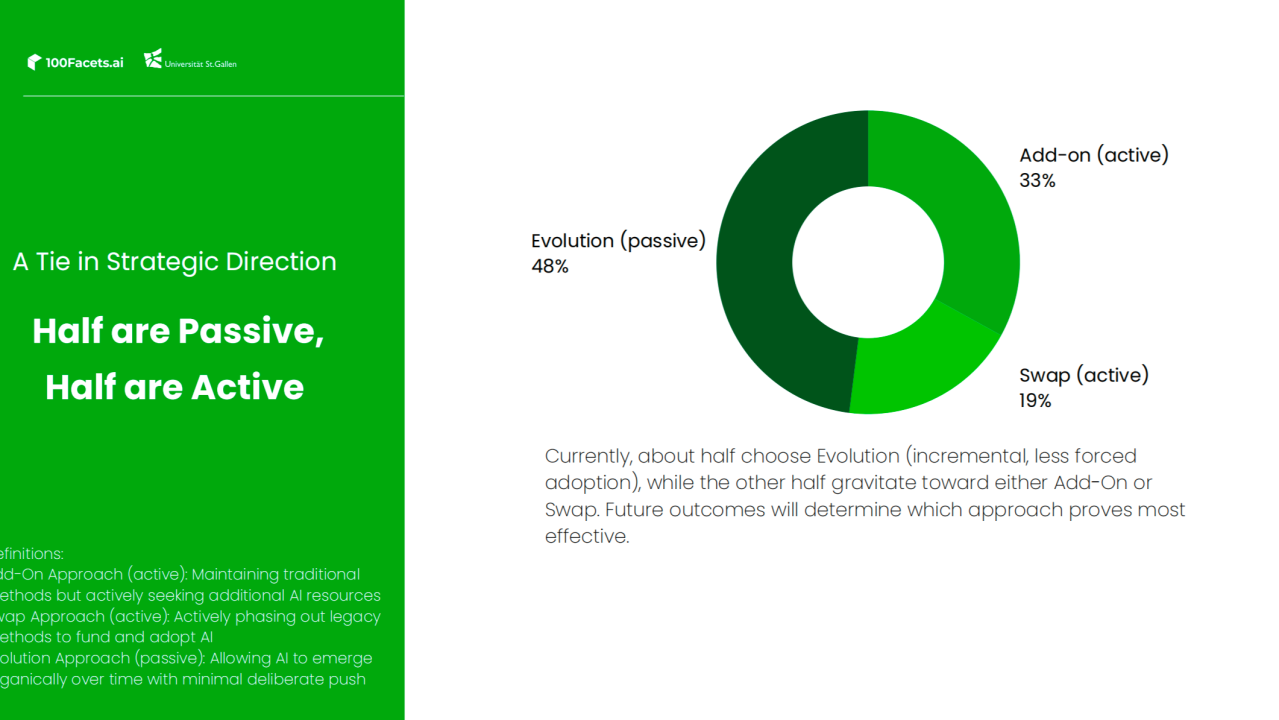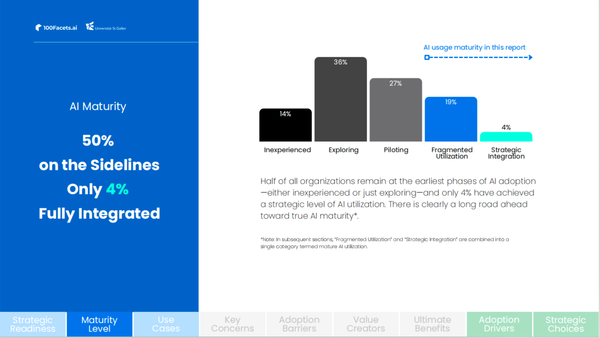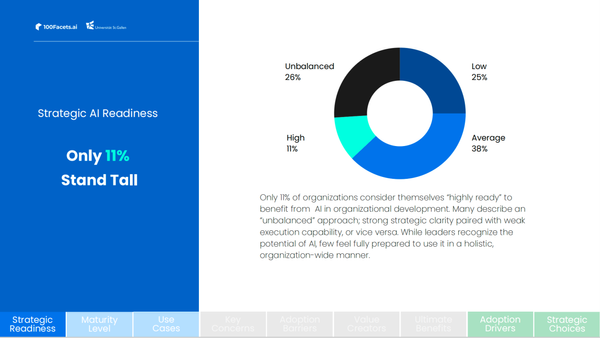Strategic Choices for AI: Add On, Swap Out, or Just Evolve?

Our research by 100facets.ai and University of St.Gallen (HSG) – Executive School with 155 senior HR and L&D leaders reveals a near split in AI adoption approaches: 48% choose a passive “evolution” strategy—letting AI emerge organically—while the remaining half splits into “add-on” (33%) and “swap” (19%). This reveals a fundamental fork in the road: wait for AI to integrate itself or proactively reshape your organization around it.
Defining the three approaches
- Evolution (Passive, 48%): Minimal deliberate push. AI initiatives surface sporadically as different teams see fit. This feels less disruptive but risks scattered efforts.
- Add-On (Active, 33%): Retain legacy methods but actively introduce AI tools on top. Think layering AI-driven analytics on existing performance reviews.
- Swap (Active, 19%): Replace older processes or systems to fund and adopt AI-driven alternatives—boldly phasing out the old in favor of the new.
The CxO vs. HR professionals Divide
Interestingly, CxOs are 2× more likely to favor “swap,” while HR/L&D professionals lean toward “add-on.” In our expert discussions, the panelists mentioned that this tension arises because top executives typically focus on strategic leaps, whereas HR strives to protect ongoing initiatives and maintain continuity. Bridging this gap requires frank dialogue about resource reallocation and willingness to retire outdated processes.

When Passiveness Becomes Problematic
Nearly half of organizations let AI “happen to them” without an overarching strategy. While it may feel safe, the data indicates that high-readiness firms are 3× more likely to opt for bolder replacements—safeguarding them from endless pilot purgatory. Passive approaches risk a constant cycle of disjointed pilots that never reach enterprise-level impact.
Choosing the Right Path
- Assess Organizational Readiness: Do you have the cultural appetite, data maturity, and leadership alignment to “swap” old ways for AI? If not, an add-on approach might be safer initially, but plan to evolve further once confidence grows. (here, our 8-A of AI assessment can shed light on the real state of your organization)
- Involve Stakeholders Early: Finance, IT, HR, and business units should align on resource prioritization. Swapping demands a bigger budget shift and buy-in, while add-on or evolution can happen with smaller pockets of support.
- Avoid Half-Measures Forever: Even if you start with an add-on or slow evolution, keep your eyes on broader transformation. The best results often require rethinking processes, not just embellishing them with AI.
- Manage the Psychological Toll: Swapping can trigger fear in teams accustomed to legacy systems. Effective change management—clear communication, role redefinition, and upskilling—can mitigate resistance.
So what?
Organizations face a strategic crossroads: passively let AI seep in, actively build on top of current structures, or boldly replace old methods with new, AI-driven solutions. The data shows no universal “best” approach, but high-readiness companies do tend to choose bigger leaps—and see bigger payoffs. Going for more active strategies is what I also recommend personally, as most of the passive approaches will slow you down in really benefiting from AI, which I think is quite risky given the importance, and speed of changes that are coming with AI.
Ultimately, your choice should reflect both your risk tolerance and your genuine readiness to integrate AI. By consciously selecting a pathway—and revisiting it as conditions change—you turn AI adoption from a scattershot experiment into a cohesive, future-focused strategy.




